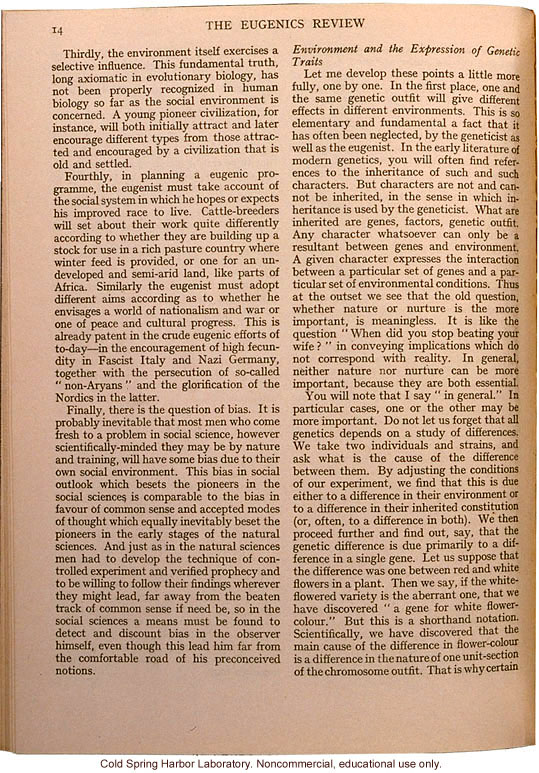14 The Eugenics Review
Thirdly, the environment itself exercises a selective influence. This fundamental truth, long axiomatic in evolutionary biology, has not been properly recognized in human biology so far as the social environment is concerned. A young pioneer civilization, for instance, will both initially attract and later encourage different types from those attracted and encouraged by a civilization that is old and settled.
Fourthly, in planning a eugenic programme, the eugenist must take account of the social system in which he hopes or expects his improved race to live. Cattle-breeders well set about their work quite differently according to whether they are building up a stock for use in a rich pasture country where winter feed is provided, or one for an undeveloped and semi-arid land, like parts of Africa. Similarly the eugenist must adopt different aims according as to whether he envisages a world of nationalism and war or one of peace and cultural progress. This is already patent in the crude eugenic efforts of to-day - in the encouragement of high fecundity in Fascist Italy and Nazi German, together with the persecution of so-called "non-Aryans" and the glorification of the Nordics in the latter.
Finally, there is the question of bias. It is probably inevitable that most men who come fresh to a problem in social science, however scientifically-minded they may be by nature and training, will have some bias due to their own social environment. This bias in social outlook which besets the pioneers in the social sciences is comparable to the bias in favour of common sense and accepted modes of thought which equally inevitably beset pioneers in the early stages of the natural sciences. And just as in the natural sciences men had to develop the technique of controlled experiment and verified prophecy and to be willing to follow their findings wherever they might lead, far away from the beaten track of common sense if need be, so in the social sciences a means must be found to detect and discount bias in the observer himself, even though this lead him far from the comfortable road of his preconceived notions.
[italics]Environment and the Expression of Genetic Traits[end italics]
Let me develop these points a little more fully, one by one. In the first place, one and the same genetic outfit will give different effects in different environments. This is so elementary and fundamental a fact that it has often been neglected, by the geneticist as well as the eugenist. In the early literature of modern genetics, you will often find references to the inheritance of such and such characters. But characters are not and cannot be inherited, in the sense in which inheritance is used by the geneticist. What are inherited are genes, factors, genetic outfit. Any character whatsoever can only be a resultant between genes and environment. A given character expresses the interaction between a particular set of genes and a particular set of environmental conditions. Thus at the outset we see that the old question, whether nature or nurture is more important, is meaningless. It is like the question "When did you stop beating you wife?" in conveying implications which do not correspond with reality. In general, neither nature nor nurture can be more important, because they are both essential.
You will note that I say "in general." In particular cases, one or the other may be more important. Do not let us forget that all genetics depends on a study of differences. We take two individuals and strains, and ask what is the cause of the difference between them. By adjusting the conditions of our experiment, we find that this is due either to a difference in their environment or to a difference in their inherited constitution (or, often, to a difference in both). We then proceed further and find out, say, that the genetic difference is due primarily to a difference in a single gene. Let us suppose that the difference was one between red and white flowers in a plant. Then we say, if the white-flowered variety is the aberrant one, that we have discovered "a gene for white flower-colour." But this is a shorthand notation. Scientifically, we have discovered that the main cause of the difference in flower-colour is a difference in the nature of one unit-section of the chromosome outfit. That is why certain
[end]


